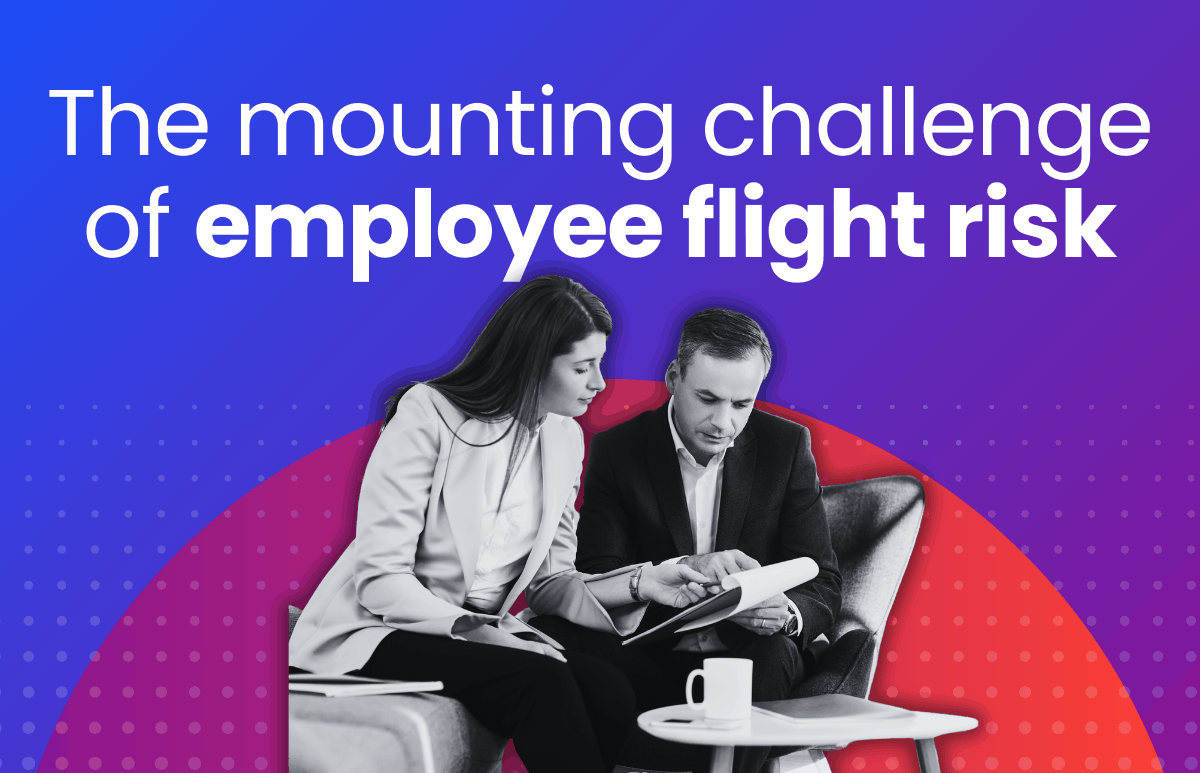The Mounting Challenge of Employee Flight Risk
Employee turnover isn’t just a seasonal issue, it’s an ongoing challenge. Losing skilled team members can derail momentum, increase costs, and leave critical gaps in knowledge and culture.

In today’s highly competitive job market, identifying and retaining flight risk employees has become a top priority, especially for HR departments. But what makes someone a flight risk, and how can organisations respond proactively?
This guide unpacks the root causes, signs, and remedies for managing employee flight risk.
What’s a flight risk employee?
A flight risk employee is someone showing signs they may leave their job soon. These individuals might be high performers, key contributors, or rising stars who are quietly (or not so quietly) disengaging.
Losing them doesn’t just mean backfilling a role either. It can easily contribute to overall morale, delay the delivery of projects and marches institutional knowledge out the door.
Why does flight risk matter in 2025?
With hybrid work reshaping job opportunities, loyalty is no longer as guaranteed. Employees can explore new roles more easily, and talent competition is fiercer than ever.
Consider some recent findings:
- For ANZ ‘time to productivity’ for a new hire is 34 days and ‘cost to hire’ is AUD $18600 (ELMO HRIB)
- 40% of employees globally are considering a job change this year (McKinsey & Company)
- Voluntary turnover rates are now over 19% worldwide (Mercer)
The true cost of employee turnover
Employee turnover can create a strong ripple effect across your organisation. So, what’s at stake?
- Significant recruitment costs and onboarding time
- Lost productivity and stalled initiatives
- High pressure on the remaining team members
- Manager’s time diverted to training and onboarding
- Poor customer relationships or continuity
When you multiply these effects across multiple departures, such employee turnover quickly becomes an expensive issue that can quickly put your organisation on the back foot.
Understanding the root causes of flight risk
Employees can certainly leave an organisation for a wide range of reasons. However, you’ll find that there are some common themes across a range of roles and industries. It’s good to be aware of the following.
Career advancement limitations
If your employees can’t envision a future with your organisation, they’ll start exploring other options. In our recent Employee Sentiment Report (ESI) we found that in the first three months of 2025, 20% of employees were actively looking for a new job.
Compensation and benefits dissatisfaction
Attractive pay and meaningful benefits are of high impotence, as you can imagine. loyal employees will still exit if they feel perpetually undervalued or underpaid.
Shifting work/life expectations
Today’s post-COVID workforce undoubtedly expects greater flexibility and autonomy. This doesn’t just mean hybrid work or location freedom, but also how work fits into their broader life
Leadership and management issues
Poor relationships with direct reports or managers are a major predictor of flight. It’s pretty clear that employees split due to leaders, not just companies.
Meaning and purpose
Employees want to feel connected to their work and derive meaningful value from it. When that kind of connection or purpose is missing, employee disengagement flourishes.
Workplace flexibility
As we brushed upon, rigid and outdated work structures or expectations can drive talent away, especially if your competitors are more attractive, especially in a post-pandemic landscape. According to our latest ESI, Australian employees ranked flexible work as the most important benefit after salary.
Life events and major transitions
Major life changes are a solid predictor of flight risk. Such events include marriage, moving home, caregiving responsibilities or health issues etc. You won’t be able to prevent these from happening but how your organisation supports them during this upheaval will be important.
Early warning signs: How do you detect flight risk before it’s too late?
Employees who present a flight risk will often signal their state of mind through subtle behavioural changes. If you can spot these signs early, you‘ll obtain a critical advantage and may be able to head it off. What should you be looking for?
Productivity and performance changes
Many who are on their way out the door will display a noticeable drop in work quality, start missing deadlines, become increasingly disengaged, or reduce their level of initiative and application.
Engagement and motivation shifts
You could also start to see less participation in meetings, lower enthusiasm, and minimal interest in company updates. These are all early red flags.
Attendance and leave patterns
You start to notice an increase in unplanned leave, lateness or unexplained absences. These can all suggest your employee is checked out and may soon be out the door.
Collaboration and communication signals
There can be withdrawal from team interactions or less responsiveness in general. A lack of communication can definitely be a strong signal of worker dissatisfaction.
Career development disinterest
Employees avoiding learning opportunities or stretch assignments may be mentally preparing to leave.
Data-driven flight risk assessment
To start to map flight risks more earnestly, it can be a good approach to combine your HR expertise and intuition with solid data to enable more accurate, proactive decision-making.
Essential data points for flight risk analysis
- Tenure and time in current role
- Recent performance ratings
- Promotion or lateral movement history
- Employee engagement scores
- Exit interview trends
Implementing an employee flight risk matrix
Use a matrix combining employee value and flight risk probability to prioritise interventions.
Analytics tools and approaches
Leverage predictive HR analytics platforms or build in-house models using historical attrition data, or flight risk calculators.
Measuring flight risk accuracy
Track actual turnover outcomes against model predictions to refine your approach over time.
Ethical considerations in flight risk analytics
Be transparent, guard against bias, and ensure employee privacy is respected in any predictive process.
Strategic retention: Targeted interventions for flight risk employees
So, you’ve identified a flight risk, now what? Targeted actions can make a real difference, such as the following actions.
Compensation and benefits optimisation
Use benchmarking to ensure offers remain competitive in a shifting market.
- Career pathing and development programs: Make internal growth visible and achievable. Communicate future opportunities.
- Manager effectiveness training: Equip leaders to have stay interviews, offer feedback and build trust.
- Flexibility and work-life integration: Offer adaptable work arrangements based on team needs and employee preferences.
- Recognition and rewards reimagined: Celebrate wins publicly. Tailor recognition to what matters most to each team.
- Wellbeing and mental health support: Proactively offer resources, training and open dialogue around burnout and stress.
- Stay interviews and proactive conversations: Ask employees what keeps them engaged, and what might cause them to leave.
How to implement a comprehensive flight risk management program
A flight risk strategy isn’t a one off task or tick-box, it requires you to embed this kind of thinking into your everyday operations. Here’s a few ways you can do this.
- Stakeholder alignment and responsibility: Get leadership, managers and HR aligned on what success looks like.
- Integration with HR systems and processes: Ensure insights from surveys, performance reviews and exit interviews inform the strategy.
- Measure program effectiveness: Track retention of high-potential employees and adjust as needed.
- Continuous improvement framework: Regularly review, learn and adapt based on feedback and results.
Your Flight Risk Action Plan
IMMEDIATE ACTIONS
(NEXT 30 DAYS)
MEDIUM TERM
(90 DAYS)
LONG TERM
(12 MONTHS)
The future of flight risk management
As the workplace evolves, flight risk strategies will become even more sophisticated.
- AI and machine learning applications: Automated models can scan signals like sentiment, productivity and engagement trends.
- Passive flight risk monitoring: With consent, tools can detect disengagement without surveys, reducing survey fatigue.
- Predictive intervention models: Smart alerts can prompt manager conversations at the right time.
- Creating lasting loyalty: Long-term success lies not just in reducing exits, but in building deep employee commitment.
 HR Core
HR Core 









